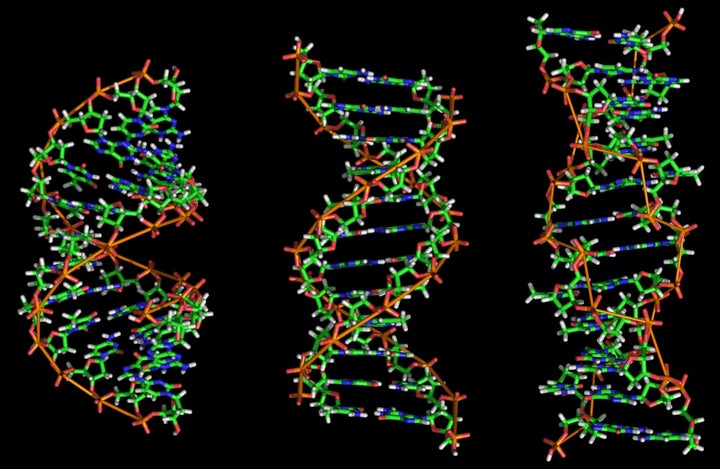
In a recent essay in the New York Times, Aaron Gilbreath recounted lessons on writing he'd learned from Miles Davis. Miles' sounds and silences, Gilbreath said, taught him "the value of experimentation and reinvention, the fact that it was all right to change, to try new styles." As I read this I thought: experimentation, reinvention, trying new things... that's math!
Don't stop reading! Bear with me; this really is about Miles Davis and the double helix. But first I want to tell a story about the mathematical genius Carl Friedrich Gauss. The year was 1787; the setting a small schoolhouse in Brunswick, Germany. Ten-year-old Carl, so the legend goes, was too much for his harried teacher. To keep the boy busy for awhile, he gave him a daunting math problem: add up the numbers from 1 to 100.
There being no pocket calculators in 1787, your average kid would grit his or her teeth and slog away: first 1 + 2 = 3, then 1 + 2 + 3 = 6, then 1 + 2 + 3 + 4 = 10, and on and on. Brighter bulbs would cast about for a shortcut, a pattern in these sums. But little Carl, prefiguring Miles, reinvented the problem and solved it in seconds.
The teacher set the theme:
1 + 2 + 3 + ... + 98 + 99 + 100.
Carl read it backwards:
100 + 99 + 98 + ... + 3 + 2 + 1.
Improvising on the spot, he played forward and backward together, up and down:
(1 + 100) + (2 + 99) + (3 + 98) + ... (98 + 3) + (99 + 2) + (100 + 1).
Boing! Each pair of numbers has the same sum, 101, and there are 100 pairs! So the theme forward plus backward add up to 100 x 101. Now divide by 2 since you've double-counted. 5050, Carl told his dismayed teacher.
That's jazz, isn't it? But wait! you say, what about the two cultures? Math and science belong to one, jazz and writing to the other, and the cultures are worlds apart.
C. P. Snow (1905-1980), who coined the phrase "two cultures" in 1959, was a scientist and a novelist and, off and on, a government official. He drew on all three personas in his influential lecture. "There have been plenty of days when I have spent the working hours with scientists and then gone off at night with literary colleagues," he said. "Constantly I felt I was moving among two groups ... who had almost ceased to communicate at all." Snow argued that this is dangerous in a world beset with problems whose solutions require both scientific and humanistic understanding. Heeding Snow's words, scientists and humanists have built bridges across the chasm -- public events like the annual World Science Festival in New York, hit plays like Michael Frayn's Copenhagen, and endless interdisciplinary symposia. This is all to the good. But ironically, thanks to Snow, one thing the two cultures have in common today is the phrase itself. Names reify. The more we bemoan the "two cultures" the more real they seem, obscuring profound connections in plain sight.
Forget the end products for a moment, the scientific discoveries, artistic creations. Forget creationism and math phobia. Externals aside, the two cultures are a lot alike on the inside, what its denizens do. I've already mentioned experimenting, reinventing, trying new things. Here's another similarity. Writers use style to convey meaning; scientists do too, often without knowing it. A friend who teaches creative writing laments that science students in her classes ignore the messenger and bee-line for "the message." To them, Italo Calvino's musical phrase, "And what a variety of windows looks down on the streets: mullioned, Moorish, lancet, pointed, surmounted by lunettes of stained-glass roses," says there are different kinds of windows. How can she convince them that cadences -- and silences -- carry subtle content? Her students might understand if they pondered the models on the shelves in their labs: what they say and how they say it. Models direct our thoughts along certain lines. The double helix, for example. That elegant twisted stepladder -- to paraphrase Gilbreath -- is melodic and economical, concise and suggestive. Real DNA, the molecule in your every cell, looks nothing like this. The real molecule is cluttered, complicated; you might miss the stepladder entirely. Biologists strip it to bare bones to convey properties they consider important and suppress others.
Which brings me back to Snow. Reading his lecture, you see what appalled him. Scientists don't read Shakespeare, and literary types can't state the Second Law of Thermodynamics! The beautiful experiment for which Yang and Lee won the 1957 Nobel physics prize should have been discussed at Cambridge High Tables -- but was it?
I have a different question. Why didn't Snow ask whether Cambridge dons discussed the double helix? It wasn't a household phrase yet, but Snow knew about it and he knew its back story. One of his early novels was sparked by the upstart Theoretical Biology Club. Snow knew its members well, I'm told: the then-biochemist Joseph Needham, the geneticist Conrad Waddington, the mathematician Dorothy Wrinch, and John Desmond Bernal, the prophet of molecular biology. Constantine, the book's main character, is a ringer for the young Bernal.
Maybe Snow thought molecular biology was "immature." Physics, with its interlocking network of fundamental laws, was the grownup in the room. Chemistry and biology aspired to that, or should; psychology and sociology too.
That once-widely-held picture of science has vanished. Snow's two cultures metaphor should too. Don't think mountains capped by physics and fiction. Think helices: sciences and humanities, bonded by their affinities, the intertwined blueprint of one culture. Think jazz.